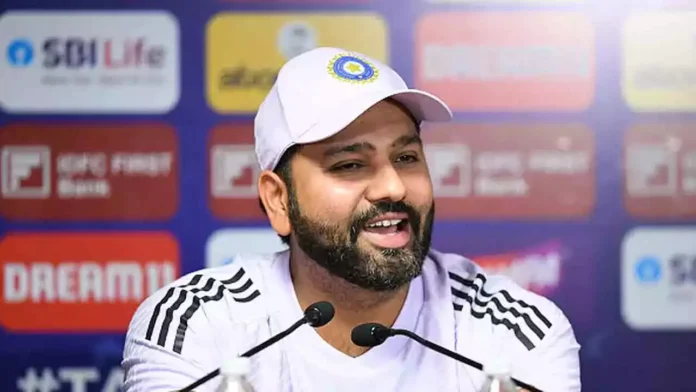Rohit Sharma’s recent struggles with his batting have raised questions about his ability to turn the tide in the upcoming second ODI against England at Cuttack’s Barabati Stadium. Once known for his impeccable technique and consistency, the Indian opener is now faced with a challenge that could define his career in the short term. The 2025 series has highlighted technical deficiencies and an inability to tackle the strategic complexity posed by England’s attack, prompting cricket fans and pundits alike to wonder if the “Hitman” can find his rhythm again.
At the center of the problem is a flaw in Rohit’s usually solid footwork, which has begun to betray him in recent matches. His signature pull shots and cover drives, once near-unplayable, have not been as effective in recent outings. The lack of fluidity in his movement has made him vulnerable against both pace and spin. This newfound weakness comes at a time when India needs its most experienced opener to provide a solid foundation at the top of the order. His recent technical lapses were especially evident in the first ODI against England, where he fell early to a delivery he would have easily put away in the past.
The second ODI at Cuttack represents a crucial moment for Rohit to turn things around. The venue itself offers unique challenges for batsmen, with the Mahanadi River’s humid winds and the pitch offering variable bounce. Historically, the surface at Barabati has been kind to both batsmen and bowlers, depending on the conditions, and Rohit needs to adjust his game to suit this scenario. He has the ability to play the long innings, and if he overcomes his current difficulties, he can capitalize on the pitch’s nature.
Rohit’s struggles are compounded by the larger tactical questions surrounding India’s middle order. The Indian team management will have to figure out how to balance the inclusion of Shreyas Iyer and the peculiar left-hander issue. England’s bowlers, particularly their spinners, have been known to exploit right-handed batters, and Rohit’s performance will be instrumental in determining the team’s approach. It’s a delicate balance for India to maintain, and Rohit, as captain, will have to lead from the front, showing the way in overcoming these tactical puzzles.
For a cricketer of Rohit Sharma’s stature, confidence plays a huge role. His technical flaws are evident, but they are not insurmountable. He has the ability to reassess his stance, his bat swing, and his footwork. Rohit has faced slumps in the past but has always managed to find a way to bounce back. His natural instincts and vast experience in international cricket remain a significant advantage. The key to unlocking his potential once more will be in adapting his technique to the challenges that Cuttack offers.
The second ODI also holds personal significance for Rohit, who has often spoken about the importance of adapting to different pitches. Playing at Cuttack, where the conditions are likely to test him more, could give Rohit the ideal opportunity to rediscover his form. The batter has previously made comebacks after rough patches, and the game against England presents the perfect platform to do so again.
Another key factor in this equation is the support system around Rohit. Players like Virat Kohli and Shreyas Iyer can play a critical role in taking the pressure off him, especially if they start well at the other end. Rohit will not be the only one under scrutiny, and his teammates can offer valuable breathing space as they look to build partnerships. That said, it’s up to Rohit to set the tone and steer the team toward victory in the second ODI.
With the series on the line, Rohit Sharma’s ability to overcome his technical deficiencies and handle the tactical challenges posed by England will be the crux of India’s performance at Cuttack. It is now a matter of whether the seasoned opener can rise to the occasion and show why he remains one of the most formidable players in the modern game. Fans and analysts alike will be watching closely as Rohit looks to redeem himself and prove that his strengths, though momentarily weakened, are far from gone.
The pressure surrounding Rohit Sharma’s form is not just a personal challenge, but one that has wider implications for the Indian team as well. His failure to fire in the first ODI has led to concerns about the stability of the top order. With key players like KL Rahul and Shubman Gill also looking to cement their spots, Rohit’s inability to contribute at the start could potentially place additional pressure on them. It’s a reminder of how the success of the opening batsman can set the tone for the entire innings. Rohit’s early dismissal, especially in a high-profile series like this, can cause a domino effect, impacting the flow of the match and even the confidence of the middle order.
Rohit, however, has always been a player who thrives in challenging situations. His remarkable ability to adapt has been one of his key strengths over the years. From facing some of the most formidable bowlers in the world to making crucial adjustments to his technique when the situation demands, Rohit has time and again proven his mettle. There’s a sense of belief that, despite his recent struggles, he has the temperament and skills to turn things around. His calm demeanor and leadership will be pivotal not just for his own game but for the team’s morale too.
Another factor that could play into Rohit’s hands in the second ODI is the home crowd support at Barabati Stadium. Indian cricketers tend to perform better when playing in front of passionate home fans, and Cuttack is no exception. The electric atmosphere can serve as an impetus for a player who knows the significance of this series for both himself and the country. Rohit has often spoken about the confidence that comes from playing at home, and if the crowd backs him, it could provide the perfect lift for him to rediscover his best form.
In addition to his technical adjustments, Rohit will have to take a more strategic approach to his batting in the upcoming match. England’s bowlers, led by their spinners, have been known to exploit weaknesses in the top order. The likes of Moeen Ali and Adil Rashid can pose significant challenges for right-handed batters, especially when the pitch offers variable bounce. Rohit, however, has dealt with similar challenges throughout his career and will need to adjust his game accordingly. A more compact defensive approach, followed by aggressive shot selection when the time is right, could be the formula for success.
While the spotlight may be on Rohit’s batting, the overall team dynamics will also play a crucial role in India’s success at Cuttack. A solid partnership at the top of the order is often the foundation for big scores, and Rohit’s ability to anchor the innings will give the middle order the freedom to accelerate. Virat Kohli’s presence in the middle order, with his vast experience and ability to play in various conditions, will complement Rohit’s efforts. Together, they could provide the stability needed to counter the challenges posed by England’s bowlers.
Finally, it’s essential to remember that no player’s career is without its rough patches. Rohit Sharma’s journey has seen both highs and lows, but his resilience has always been a defining characteristic. As the second ODI approaches, there is a sense of anticipation about whether he can deliver when the team needs him the most. While the pressure is undoubtedly high, Rohit Sharma has the pedigree and skillset to rise above the challenges and prove that his best years are still ahead of him. Whether or not he can turn things around at Cuttack remains to be seen, but one thing is for certain: Rohit’s resolve to overcome adversity is something that defines him both as a player and as a leader.



